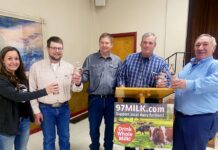In the traveling journal of Laura Ingalls Wilder, it is interesting to read not only of their daily trials and tribulations as they headed west in their covered wagon, but of the local farming struggles in the barren soil of 1894.
“The banks of the Missouri are crumbling all the time and falling into the water. In one place the road had fallen in. There on the river flats before we reached the bluffs we saw 24 hay stacks at one time, and mowing had only begun. Four mowing machines were working. Hay is $9 a ton in Yankton.”
Notes along the way. Somewhere in Nebraska, as the family traveled in covered wagon from South Dakota to Missouri, Laura noted, “There has been plenty of rain right here and crops are good – corn, wheat and oats. But three miles west they have nothing. Land is $25 an acre here.”
She continues, “So far Nebraska reminds me of Lydia Locket’s pocket, nothing in it, nothing on it, only the binding round it.”
As temperatures climbed during their summer journey, the travelers were weary from fighting heat and incredibly suffocating dust, and the worry of running out of food and water was constant.
“The hens are laying yet. Temperature 110.”
Laura wrote, “Just south of Coleridge there are 22 families that are going to start for Missouri in about 6 weeks, though this country is very thinly settled.
“One man said he has lived here for six years and has not seen a good crop yet. The man living near where we camped is working for a man in Sioux City who owns 3,000 acres of land here, in a body, 500 acres of it are in pasture and 250 in meadow.”
Going on faith. One day she notes in her 5-cent notebook, “Crops are poor since noon, country about as dry as Dakota.”
Think of the blind faith that would have been required to begin such a journey. So many undertook it, and it strikes me as incredibly brave.
When I read of their conversations with others, I wonder how they kept going.
“This afternoon we met a family of emigrants, man, woman and two children. They had been to Missouri and are coming back. They stayed only 10 days and started back. They would not live in Missouri if you gave them the whole of it.”
She quoted the man, “Why, hardly any of the houses have windows in them, just holes, and lots of the women have never seen a railroad train nor an organ,” one of those travelers told Laura, adding that the land in Missouri is very stony.
And yet, they continued on, seeing and hearing only that which they needed to continue keeping the faith of a better life.
Toward the Ozarks. “Crossed the line into Stanton County at 9. There are large pastures and the grain fields are all fenced. A good many sleek cattle are in sight. Cornfields are 3 miles long and as far back as you can see. There are a few groves. At 10:20 we saw an orchard with apples!”
She writes on July 27, “The hills are covered with corn as far as eye can see, acres and acres of corn. Lots of groves. Nearly all the people are Germans. One man gave us two large apples off his trees. He has a large orchard and the trees hang full. Just passed a house where the man owns 540 acres of land and has 300 hogs.
“A little father on, a farm of 500 acres. The owner had 450 hogs and only 50 bushels of old corn. He says if it does not rain within 24 hours the tassels on the new crop will dry and he will not harvest a kernel of corn.
“The corn looks nice to us but I suppose the farmers here know. Their wheat only sold for 32 cents last year and it is 32 cents now.”
Later that day she writes, “Found an ear of corn 10 inches long, 7 1/2 inches around!”
Next week: the family reaches the Ozarks.
Get 4 Weeks of Farm and Dairy Home Delivered











